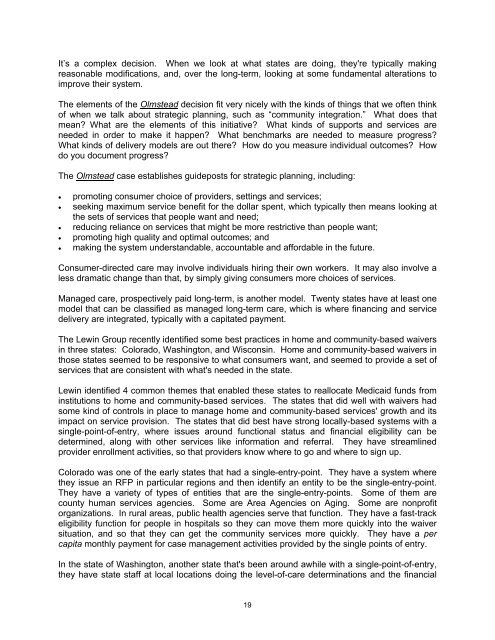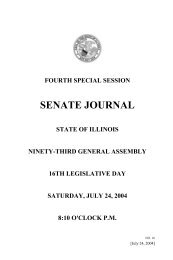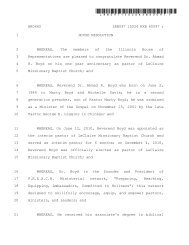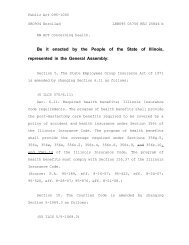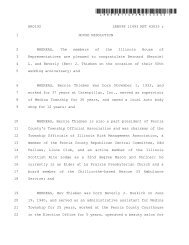Long-Term Care - Illinois General Assembly
Long-Term Care - Illinois General Assembly
Long-Term Care - Illinois General Assembly
You also want an ePaper? Increase the reach of your titles
YUMPU automatically turns print PDFs into web optimized ePapers that Google loves.
It’s a complex decision. When we look at what states are doing, they're typically making<br />
reasonable modifications, and, over the long-term, looking at some fundamental alterations to<br />
improve their system.<br />
The elements of the Olmstead decision fit very nicely with the kinds of things that we often think<br />
of when we talk about strategic planning, such as “community integration.” What does that<br />
mean? What are the elements of this initiative? What kinds of supports and services are<br />
needed in order to make it happen? What benchmarks are needed to measure progress?<br />
What kinds of delivery models are out there? How do you measure individual outcomes? How<br />
do you document progress?<br />
The Olmstead case establishes guideposts for strategic planning, including:<br />
• promoting consumer choice of providers, settings and services;<br />
• seeking maximum service benefit for the dollar spent, which typically then means looking at<br />
the sets of services that people want and need;<br />
• reducing reliance on services that might be more restrictive than people want;<br />
• promoting high quality and optimal outcomes; and<br />
• making the system understandable, accountable and affordable in the future.<br />
Consumer-directed care may involve individuals hiring their own workers. It may also involve a<br />
less dramatic change than that, by simply giving consumers more choices of services.<br />
Managed care, prospectively paid long-term, is another model. Twenty states have at least one<br />
model that can be classified as managed long-term care, which is where financing and service<br />
delivery are integrated, typically with a capitated payment.<br />
The Lewin Group recently identified some best practices in home and community-based waivers<br />
in three states: Colorado, Washington, and Wisconsin. Home and community-based waivers in<br />
those states seemed to be responsive to what consumers want, and seemed to provide a set of<br />
services that are consistent with what's needed in the state.<br />
Lewin identified 4 common themes that enabled these states to reallocate Medicaid funds from<br />
institutions to home and community-based services. The states that did well with waivers had<br />
some kind of controls in place to manage home and community-based services' growth and its<br />
impact on service provision. The states that did best have strong locally-based systems with a<br />
single-point-of-entry, where issues around functional status and financial eligibility can be<br />
determined, along with other services like information and referral. They have streamlined<br />
provider enrollment activities, so that providers know where to go and where to sign up.<br />
Colorado was one of the early states that had a single-entry-point. They have a system where<br />
they issue an RFP in particular regions and then identify an entity to be the single-entry-point.<br />
They have a variety of types of entities that are the single-entry-points. Some of them are<br />
county human services agencies. Some are Area Agencies on Aging. Some are nonprofit<br />
organizations. In rural areas, public health agencies serve that function. They have a fast-track<br />
eligibility function for people in hospitals so they can move them more quickly into the waiver<br />
situation, and so that they can get the community services more quickly. They have a per<br />
capita monthly payment for case management activities provided by the single points of entry.<br />
In the state of Washington, another state that's been around awhile with a single-point-of-entry,<br />
they have state staff at local locations doing the level-of-care determinations and the financial<br />
19


